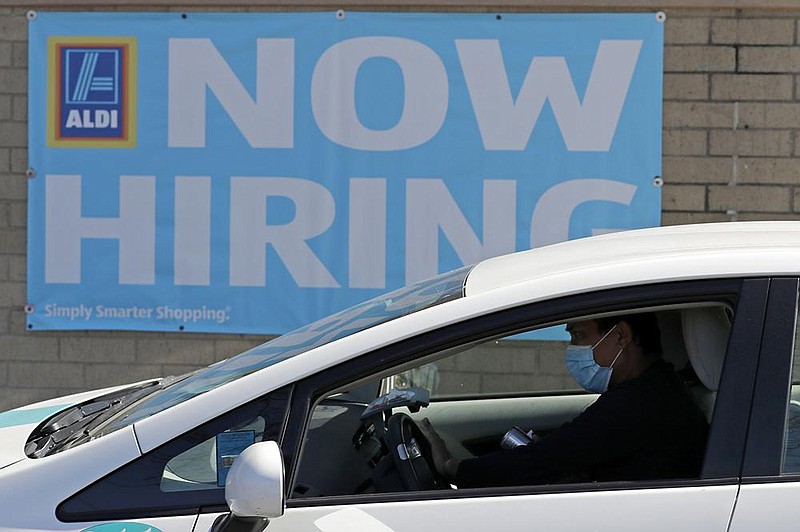WASHINGTON -- New claims for unemployment benefits fell last week as the nation celebrated Thanksgiving.
Thursday's report from the Labor Department said that initial claims for jobless aid dropped to 712,000 from 787,000 the week before. Before the virus paralyzed the economy in March, the number of people applying for unemployment benefits each week had typically amounted to roughly 225,000. The chronically high pace of applications shows that nearly nine months after the pandemic struck, many employers are still slashing jobs.
"Thanksgiving seasonals likely explain the drop" in jobless claims last week, Ian Shepherdson, chief economist at Pantheon Macroeconomics, wrote in a research note. "Expect a rebound next week."
All but 10 states and territories posted unadjusted declines in initial claims last week, with some of the biggest drops occurring in California, Texas, Michigan and Georgia. Illinois, Oregon and Indiana reported the largest increases in filings during the holiday week.
[CORONAVIRUS: Click here for our complete coverage » arkansasonline.com/coronavirus]
The total number of people who are continuing to receive traditional state unemployment benefits declined to 5.5 million from 6.1 million. That figure is down sharply from its peak of nearly 23 million in May. It means that some jobless Americans are finding jobs and no longer receiving aid. But it also indicates that many of the unemployed have used up their state benefits, which typically expire after six months.
Seasonal adjustments on claims data tend to be trickier around holidays, and last week included Thanksgiving, making it important to see if the trend holds.
With layoffs still elevated and new confirmed viral cases rising, the economy's modest recovery is increasingly in danger. States and cities are issuing mask mandates, limiting the size of gatherings, restricting restaurant dining, closing gyms or reducing the hours and capacity of bars, stores and other businesses.
Many jobless Americans are now collecting checks under two federal programs that were set up this year to ease the economic pain inflicted by the pandemic. But those programs are set to expire the day after Christmas. When they do, benefits will end completely for an estimated 9.1 million unemployed people.
The number of people collecting aid under one of those programs -- the Pandemic Unemployment Assistance program, which offers coverage to gig workers and others who don't qualify for traditional benefits -- fell by 339,000 to 8.9 million for the week ending Nov. 14.
But the number of people receiving aid under the second program -- the Pandemic Emergency Unemployment Compensation program, which provides 13 weeks of federal benefits to people who have exhausted their state aid -- rose by 60,000 to 4.6 million.
20 MILLION GETTING AID
All told, roughly 20.2 million people are now receiving some type of unemployment aid. (Figures for the two pandemic-related programs aren't adjusted for seasonal variations.)
Still, the Government Accountability Office, a federal watchdog, has concluded that the jobless claims numbers are being distorted by flaws in the way the government collects the data. The office said the problem arose because the Labor Department uses state numbers as a proxy for the number of people claiming benefits nationwide. But backlogs in state processing of claims and other data-collection problems have resulted in inaccurate counts, the office reported.
For months, Congress has failed to agree on any new stimulus aid for jobless individuals and struggling businesses after the expiration of a multitrillion dollar rescue package enacted in March. This week, though, efforts to forge some limited short-term rescue package have intensified.
President-elect Joe Biden lent his support to the bipartisan effort Wednesday, saying the developing aid package "wouldn't be the answer, but it would be the immediate help for a lot of things." Biden said he wants a relief bill to pass Congress now, with more aid to follow next year.
BRACING FOR SETBACKS
Regardless of what happens on Capitol Hill, the promise of a vaccine could help ease the health and economic crises in coming months. In the meantime, with the virus still raging, the economic damage has become increasingly visible.
The data firm Womply estimates that 21% of small businesses were shuttered at the start of November, up from June's 16% rate. Womply also said that consumer spending at local businesses declined 30% last month from a year earlier, marking a deterioration from a 20% year-over-year decline in October.
Americans are bracing for the picture to worsen: Thirty percent of adults surveyed by the Commerce Department from Nov. 11 to 23 reported that they or someone in their household expected to lose income in the next four weeks, up from 23% of those surveyed from Sept. 30 to Oct. 12.
The data show a labor market that "continues to progress through the pandemic, but still has a long road to a complete recovery," Ian Lyngen, head of U.S. rates strategy at BMO Capital Markets, said in a note.
Information for this article was contributed by Paul Wiseman of The Associated Press and by Jarrell Dillard of Bloomberg News.
